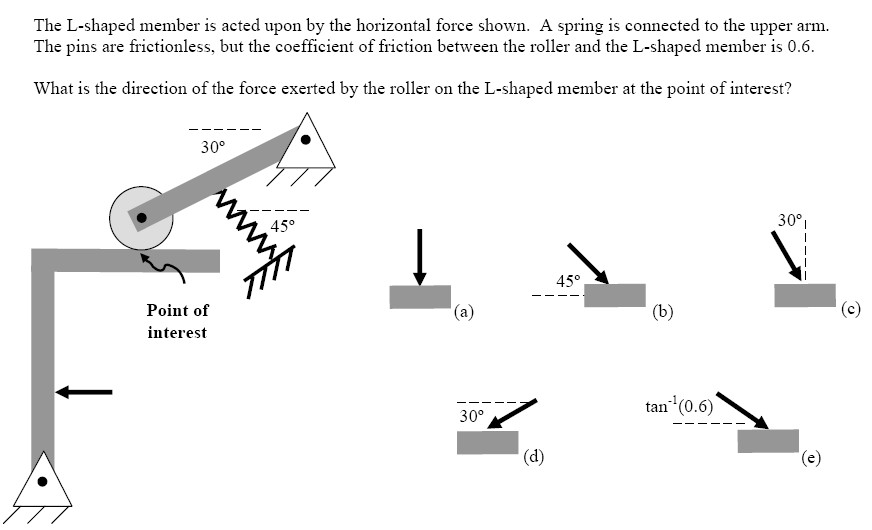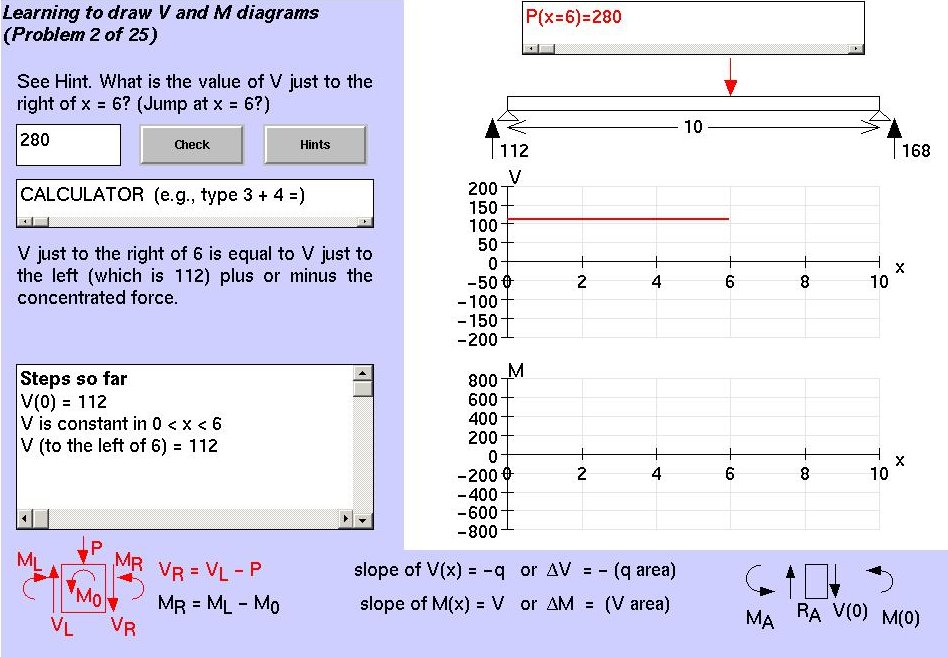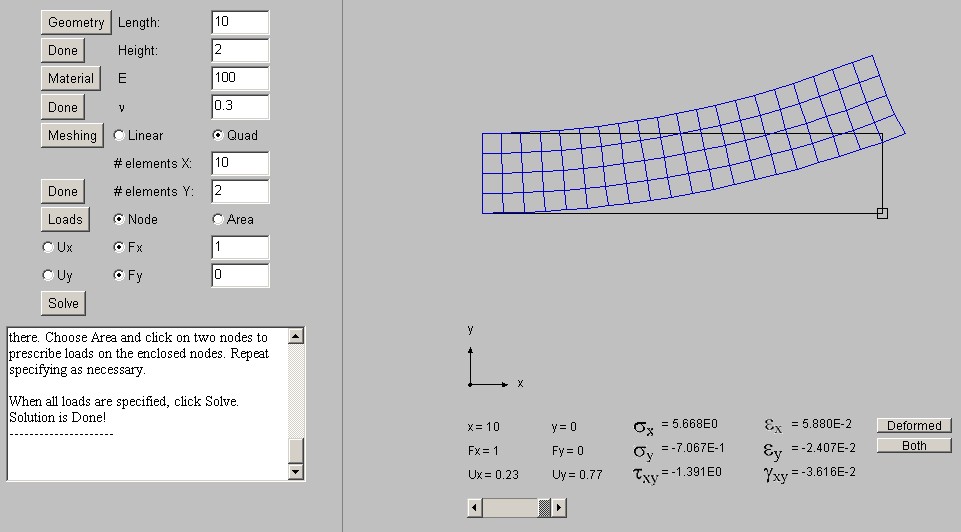
Educational Research of Professor Paul S. Steif
Paul Steif, a professor of mechanical engineering at Carnegie Mellon University, pursues a two-pronged research and development program related to engineering education:Most of Professor Steif's work currently addresses learning in Statics and Mechanics of Materials.
Table of Contents
Conceptual Basis for Statics
Concept Inventory for Statics
Promoting
Problem Solving Ability in Statics through Body-Centered Talk
Reorganization of Statics Instruction
Web-based Course in Statics
Problem Solving Courseware for Mechanics of Materials
Elementary FEA to Improve Visualization of Deformation
Modeling of Engineering Systems
Computer Tutor for Truss Analysis
This project is aimed at identifying the fundamental concepts which are necessary to learning Statics and how students understand and misunderstand those concepts. We arrive at students perceptions of concepts through interviews of students' and analysis of errors they commit while solving problems. A set of fundamental concepts and skills can provide a principled basis both for instruction and for assessing learning. This project is funded by the National Science Foundation.
P. S. Steif, “An Articulation of the Concepts and Skills which Underlie Engineering Statics,” 34th ASEE/IEEE Frontiers in Education Conference, Savannah, GA., October 21-23, 2004. [Download PDF, 169KB]
J.L. Newcomer and P.S.
Steif, “Student Thinking about Static Equilibrium: Insights from Written
Explanations to a Concept Question,” Journal of Engineering Education,
Vol. 97, pp. 481-490, (2008).
[Download PDF, 1136KB]
(Return
to top)
Concept Inventory for Statics
Collaborators: Mary Hansen, John Dantzler, Anna Dollár
In
this project we have developed a test (the Concept Assessment Tool for Statics
or the Statics Concept Inventory) to measure a student's ability to use core
Statics concepts. Each question of the test requires the use of a single concept
in isolation and involves negligible mathematical analysis. The Statics Concept
Inventory builds upon the project addressing the Conceptual Basis for
Statics.
This test has been taken by over 2500 students prior to Statics (pre-test) and by over 4000 students after Statics (post-test) at more than 20 universities. Extensive psychometric analyses have established the reliability and validity of this test. More details can found in http://engineering-education.com/CATS-index.php.
Funded by the National Science Foundation through grant REC-0440295.
P. S. Steif and J. Dantzler, “A Statics Concept Inventory: Development And Psychometric Analysis,” J. Eng. Educ., Vol. 33, pp. 363-371, 2005. [Download PDF, 253KB]
P. S. Steif and M. Hansen, “Comparisons Between Performances In A Statics Concept Inventory And Course Examinations,” Int. J. Eng. Educ, Vol. 22, pp. 1070-1076, 2006. [Download PDF, 219KB]
P.S. Steif and M. A. Hansen, “New Practices for Administering and Analyzing the Results of Concept Inventories,” J. Eng. Educ., Vol. 96, pp. 205-212, 2007. [Download PDF, 723KB]
Below is a sample question from the Statics Concept Inventory

Promoting Problem Solving Ability in Statics through Body-Centered Talk
Collaborator: Anne Fay
This project builds on the critical relation between bodies and forces, which is inherent in the conceptual framework of Statics. In this project we investigate the hypotheses that students can be induced through instruction to talk more about the bodies present in a Statics problem, and that such talk improves problem solving performance. To this end we have developed technology for capturing student solutions of Statics problems with synchronous think aloud protocols. Solutions and protocols are graded and coded, respectively, and then analyzed to evaluate these hypotheses.
Funded by the National Science Foundation through grant REC-0440295
P. S. Steif, A. L. Fay, L. B. Kara, and S. E. Spencer “Work in Progress — Improving Problem Solving Performance in Statics through Body-Centric Talk” 36rd ASEE/IEEE Frontiers in Education Conference, San Diego, CA., October, 28-31, 2006. [Download PDF, 135KB]
P.S. Steif, J. Lobue, A. L. Fay, L. B. Kara, and S.E. Spencer, Inducing Students To Contemplate Concept-Eliciting Questions And The Effect On Problem Solving Performance, Proceedings of the 2007 American Society for Engineering Education Annual Conference & Exposition, Honolulu, HI, June 24-27, 2007. [Download PDF, 232KB]
P.S. Steif, J. Lobue, A.
L. Fay, and L. B. Kara, Improving Problem Solving Performance by Inducing Talk about Salient Problem Features,
J. Eng. Educ., Vol. 99, pp. 135-142, 2010. [PDF,
848KB]
(Return to top)
Reorganization of Statics Instruction
Collaborator: Anna Dollár
This project seeks to re-invent Statics instruction based on two premises:
We have reformulated instruction in Statics to address concepts one at a time and, initially, only in the context of forces that are readily perceived by the senses of touch and sight. Emerging from this reformulation is a series of in-class Learning Modules, featuring: objects to manipulate or examine, PowerPoint Presentations, and Concept Questions. The instructor controls the PowerPoint Presentations, which step students through a series of ideas and questions related to the objects. The Concept Questions are multiple-choice questions that assess student understanding of concepts, and which require little or no analysis.
P. S. Steif and A. Dollár, “Enriching Statics Instruction with Physical Objects”, Proceedings of the 2002 American Society for Engineering Education Annual Conference & Exposition, American Society for Engineering, Montreal,Canada, June 23-26, 2002.
A. Dollár and P. S. Steif, “Understanding Internal Loading Through Hands-On Experiences”, Proceedings of the 2002 American Society for Engineering Education Annual Conference & Exposition, Montreal, Canada, American Society for Engineering, June 23-26, 2002.
P. S. Steif and A.
Dollár, A New Approach To Teaching And Learning Statics, Proceedings
of the 2003American Society for Engineering Education Annual Conference &
Exposition, Nashville,
A. Dollár and P. S. Steif, Learning Modules For The Statics Classroom, Proceedings of the 2003 American Society for Engineering Education Annual Conference & Exposition, Nashville, TN, June 22-25, 2003. [Download PDF, 115KB]
P. S. Steif and A. Dollár, Collaborative, goal-oriented, Manipulation of Artifacts by Students during Statics Lecture, 33rd ASEE/IEEE Frontiers in Education Conference, Boulder, Co., November 5-8, 2003. [Download PDF, 131KB]
A. Dollár and P. S. Steif, “Reinventing the Teaching of Statics”, Proceedings of the 2004 American Society for Engineering Education Annual Conference & Exposition, Salt Lake City, UT, June 20-23, 2004. [Download PDF, 192KB]
P. S. Steif and A. Dollár, “Integrating Effective General Classroom Techniques With Domain-Specific Conceptual Needs”, Proceedings of the 2004 American Society for Engineering Education Annual Conference & Exposition, Salt Lake City, UT, June 20-23, 2004. [Download PDF, 316KB]
P. S. Steif and A. Dollár, “Reinventing the Teaching of Statics”, Int. J. Eng. Educ., Vol. 21, pp. 723-729, 2005. [Download PDF, 239KB]
A. Dollár and P. S. Steif, “Learning Modules for Statics,” International Journal of Engineering Education, Vol. 22, pp.381-392, (2006) [Download PDF, 670KB]
Below is a Slide of a Learning Module addressing conditions for
Equilibrium in 3-D

This course is part of a larger project to create and sustain freely available, cognitively informed learning tools designed to provide a substantial amount of instruction through the digital learning environment. Such instruction provides opportunities to teach larger numbers of students with the same amount of human instructional support, and enables both asynchronous and distance learning. The Statics course will be divided into approximately twenty modules. Each module is based on a set of carefully articulated learning objectives and contains various interactive exercises. The explanation of basic concepts capitalizes appropriately on the computer's capability for displaying digital images, video, and animations controlled by the user. Assessment is tightly integrated within each module, with students confronting frequently interspersed "Learn By Doing" exercises, which offer hints and feedback. "Did I Get It" assessments at the end of each segment allow students to determine if learning was accomplished.
Funded by the William and Flora Hewlett Foundation through Carnegie Mellon University's "Open Learning Initiative" (OLI)
A. Dollár and P. S. Steif, “Web-Based Statics Course”, 36rd ASEE/IEEE Frontiers in Education Conference, San Diego, CA.,October, 28-31, 2006. [Download PDF, 361KB]
A. Dollár and P. S. Steif, (2008) “An Interactive, Cognitively Informed, Web-Based Statics Course”, International Journal of Engineering Education, Vol. 24, No. 6, pp. 1229-1241. [Download PDF, 1287KB] (interactive paper at: http://www.ijee.dit.ie/OnlinePapers/Interactive/Dollar_Steif/StaticsCourse.html)
P.S. Steif and A. Dollar, Study of Usage Patterns and Learning Gains in a Web-based Interactive Static Course, J. Eng. Educ., Vol. 98, pp. 321-333, 2009. [PDF, 1600KB]
More information about the OLI Engineering Statics course can be found at:
http://engineering-education.com/OLI.php
(Return to top)
Problem Solving Courseware for Mechanics of Materials
In this project, we have developed software to offer students in Mechanics of
Materials an alternative, and in some respects more effective, problem solving
experience. Resulting from this investigation has been a set of six modules.
Each module focuses one key topic, such as shear force and bending moment
diagrams. Within each module there is a limited set of physical configurations,
for example beams that are simply supported or cantilevered, with a limited set
of load types. But, different problems approach the configuration in a distinct
ways. For example, some problems lead the student through the drawing of the
diagrams, some problems let the student draw the diagrams independently, and
some problems give the diagrams and have the students deduce the loads. In some
modules, such as one on axial loading, the distinct concepts associated with
each class of problem unfold in a gradual and natural way, with successive
problems building on the previous ones.
Students get immediate feedback
on whether they solve each problem correctly, and they are offered randomly
generated versions of similar problems until they can be solved correctly. This
approach allows students to develop a better grasp of fundamental principles, an
intuitive sense of the meaning of key quantities, and fluency in using relations
to solve problems. Students use modules independently and submit electronic log
files to instructors who can monitor their progress.
P. S. Steif, Computer-Based Learning Aids for Problem Solving in Mechanics of Materials, Proceedings of the 2000 American Society for Engineering Education Annual Conference & Exposition, American Society for Engineering, St. Louis, MO, June, 2000.
P. S. Steif, Courseware for Problem Solving in Mechanics of Materials, Proceedings of the 2002 American Society for Engineering Education Annual Conference & Exposition, American Society for Engineering, June 23-26, 2002.
P. S. Steif and L. M. Naples, Design and Evaluation of Problem Solving Courseware Modules For Mechanics of Materials, Journal of Engineering Education, Vol. 92, pp. 239-247, (2003). [Download PDF, 601KB]
Below is a problem from the StressAlyzer program addressing Shear
Force and Bending Moment Diagrams

More details, as well as the current version of the program, can be found at http://engineering-education.com/FEA-index.php. This project is funded by the National Science Foundation.
P. S. Steif and E. Gallagher, “Transitioning Students To Finite Element Analysis And Improving Learning In Basic Courses”, 34th ASEE/IEEE Frontiers in Education Conference, Savannah, GA., October 21-23, 2004. [Download PDF, 83KB]

M. Pantazidou and P. S. Steif, Modeling Of Physical Systems: A Framework
Based On Protocol Analysis, Proceedings of Int. Meeting on Civil Engineering
Education, Ciudad Real,
P. S. Steif and M. Pantazidou, “Identifying the Components of Modeling Through Protocol Analysis”, Proceedings of the 2004 American Society for Engineering Education Annual Conference & Exposition, Salt Lake City, UT, June 20-23, 2004 [Download PDF, 81KB]
M. Pantazidou and P. Steif, Modeling Instruction in an Environmental Geotechnics Course, Proceedings of GeoCongress 2008, New Orleans, March 9–12, ASCE Geotechnical Special Publication 178:797-804, ( 2008) [Download PDF, 83KB]
(Return to top)
Steif, P.S., Fu, L., Kara, L.B., Technical Report: Development of a cognitive tutor for learning truss analysis, 2013 [Download PDF, 1.6 MB]